
The Soviet Air Forces (Russian: Военно-Воздушные Силы Союза Советских Социалистических Республик, tr.Voenno-Vozdushnye Sily Soyuza Sovetskih Sotsialisticheskih Respublik, VVS SSSR; literally "Military Air Forces of the Union of Soviet Socialist Republics"; initialism VVS, sometimes referred to as the "Red Air Force", were one of the air forces of the Soviet Union. The other was the Soviet Air Defence Forces. The Air Forces were formed from components of the Imperial Russian Air Service in 1917, and faced their greatest test during World War II. The groups were also involved in the Korean War, and dissolved along with the Soviet Union itself in 1991–92. Former Soviet Air Forces' assets were subsequently divided into several air forces of former Soviet republics, including the new Russian Air Force. The "March of the Pilots" was its marching song.

The Soviet Navy was the naval warfare uniform service branch of the Soviet Armed Forces. Often referred to as the Red Fleet, the Soviet Navy made up a large part of the Soviet Union's strategic planning in the event of a conflict with the opposing superpower, the United States, during the Cold War (1945–1991). The Soviet Navy played a large role during the Cold War, either confronting the North Atlantic Treaty Organization in western Europe or power projection to maintain its sphere of influence in eastern Europe.

Soviet Naval Aviation was the naval aviation arm of the Soviet Navy.
Aleksandr Sergeevich Senatorov was a lieutenant-general in the Soviet Air Force.
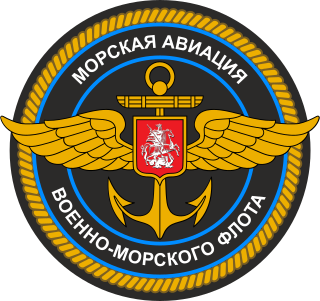
The Russian Naval Aviation is the air arm of the Russian Navy, a successor of Soviet Naval Aviation. The Russian Navy is divided into four fleets and one flotilla: Northern Fleet, Pacific Fleet, Baltic Fleet, Black Sea Fleet, and Caspian Flotilla.

Stepan Ivanovich Kretov was a Soviet World War II bomber pilot who was twice awarded the title Hero of the Soviet Union.

Long-Range Aviation (Russian: Авиация Дальнего Действия, tr.Aviatsiya dal'nego deystviya, literally Aviation of Distant Action and abbreviated DA, is a sub-branch of the Russian Aerospace Forces responsible for delivering long-range nuclear or conventional strikes by aircraft. The branch was previously part of the Soviet Air Forces and Russian Air Force tasked with long-range bombardment of strategic targets with nuclear weapons.

The Transbaikal Military District was a military district of first the Soviet Armed Forces and then the Armed Forces of the Russian Federation, formed on 17 May 1935 and included the Buryat Republic, Chita Oblast, and Yakutia. Chita was the headquarters of the district. It was finally disbanded on 1 December 1998 by being amalgamated with the Siberian Military District, though Chita remained the headquarters of the new amalgamated district.

Georgy Filippovich Baydukov was a Soviet test pilot, Hero of the Soviet Union (1936), writer and hunter.

Timofey Timofeyevich Khryukin was a Soviet aviator, Spanish Civil War volunteer, and colonel-general of the Soviet Air Force. Emerging from an impoverished working-class background, he rose to command the 8th Air Army and 1st Air Army during the Second World War, being twice decorated as a Hero of the Soviet Union before his death following a period of illness caused by a road accident.
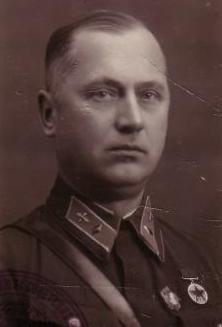
Mavriky Trofimovich Slepnyov was a Soviet polar aviator who was awarded Hero of the Soviet Union.
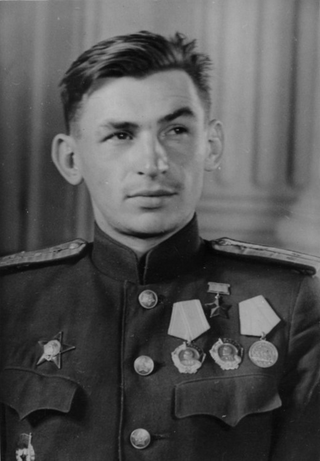
Vasily Vasilyevich Reshetnikov was a Soviet pilot who served during World War II. Reshetnikov flew 307 missions, mainly as a pilot of a long-range bomber, and in the summer of 1943, received the title of Hero of the Soviet Union. After World War II, he was named commander of an Aviation Division, Air Corps. Reshetnikov was subsequently promoted to Colonel General and took command of the Long-Range Aviation branch from 1969 to 1980 and was made Deputy Commander-in-Chief of the Air Force of the Soviet Union from 1980 to 1986.

Stepan Akimovich Krasovsky was a Soviet Air Force marshal of the aviation.

Pavel Fyodorovich Zhigarev was the commander-in-chief of the Soviet Air Forces (VVS) twice, and also served as the Chief Marshal of Aviation from 1955–1959.
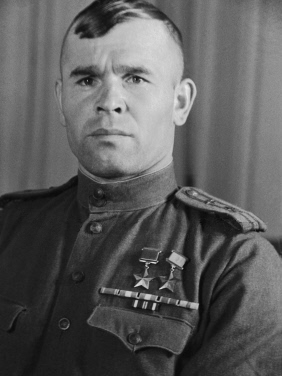
Arseny Vasilyevich Vorozheykin was a squadron commander in the Soviet Air Force and fighter ace during the Second World War. He was twice awarded the USSR's highest honor, Hero of the Soviet Union, and went on to become a Major-General of Aviation.

Yevgeny Ivanovich Kabanov was a Soviet Naval Aviation major general and Hero of the Soviet Union. During World War II, Kabanov served as a bombardier, gunner and navigator in a dive bomber aviation regiment of the Baltic Fleet. He fought in the Siege of Leningrad, the Baltic Offensive, and the Battle of Königsberg. Kabanov was awarded the title for making 103 Petlyakov Pe-2 sorties by June 1944. Postwar, Kabanov became chief navigator of the Black Sea Fleet Air Force, the 8th Fleet Air Force, and the 9th Fighter Aviation Corps. Between 1956 and 1974, Kabanov was chief navigator of Soviet Naval Aviation. He retired in 1974 with the rank of Major general and worked at GosNIIAS. He died in 1989.
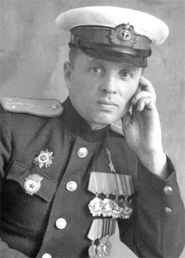
Igor Alexandrovich Kaberov was a Soviet Naval Aviation colonel, flying ace, and Hero of the Soviet Union. He fought in the Siege of Leningrad and was awarded the title for downing eight enemy aircraft. Kaberov shot down eleven and shared credit for eighteen enemy aircraft during World War II. He was withdrawn from combat in the summer of 1943 and became an instructor pilot, fighting in the Soviet invasion of Manchuria. He retired from the service in 1960 and lived in Veliky Novgorod, where he was a deputy of the city council.

Vasily Ivanovich Rakov was a pilot in the Soviet Naval Aviation who was twice awarded the title Hero of the Soviet Union in 1940 and 1945 for his actions in the Winter War and World War II respectively; afterward, he remained in the military, reaching the rank of Major-General.

Fyodor Petrovich Polynin was a Colonel general in the Soviet Air Force, who served in the Air Force of the Polish Army during World War II and received the title Hero of the Soviet Union.

Sidor Vasilievich Slyusarev was a Lieutenant general in the Soviet Air Force and recipient of the title Hero of the Soviet Union.



















